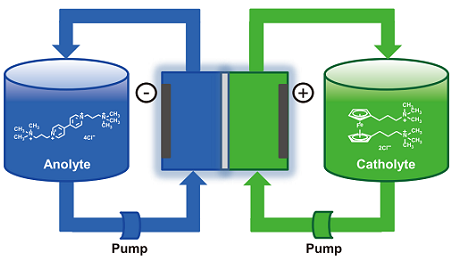Published TCIMAIL newest issue No.200 | Product Document Searching Made Easy by 2D Code! | TCI Life Science News December 2025 | [Product Highlights] Cell Culture-Ready Antibiotic... | Various analytical charts can be searched on each product detail page and Product Document Search (The kinds of analytical charts differ by product)
Maximum quantity allowed is 999
Please select the quantity
Organic Redox Flow Battery Materials [Battery Materials]
Despite the advancements and increasing popularity in renewable energies, there remains a significant need for large-scale energy storage systems to fully actualize renewable energies on a national and global scale. Redox flow batteries (RFB) are suitable for the needs of large scale energy storage systems, particularly due to their safety and long duration cycling. A conventional RFB requires metal-based active materials such as vanadium; however, its potentially high cost and limited non-renewable availability is prohibitive. In order to address cost and renewability issues, organic redox flow battery (ORFB) which takes advantage of organic active materials have received increased attention.1-3) Within a ORFB system, two solutions of organic active materials are flowed and pumped into cell stacks from separate tanks, and the charge/discharge redox cycle occurs though porous separating membrane. The catholyte solution can include organic radical materials such as TEMPO,4) and metal complexes such as ferrocene,5) whereas the anolyte solution can include viologenes6) and quinones.7) These organic active materials are useful for RFB with aqueous solutions. Additionally, phenothiazines, quinoxalines,8-9) alkoxybenzenes and fluorenones10) are suitable for RFB using non-aqueous solutions.

References
- 1) Redox‐Flow Batteries: From Metals to Organic Redox‐Active Materials
- 2) Recent developments in organic redox flow batteries: A critical review
- 3) Molecular engineering of organic electroactive materials for redox flow batteries.
- 4) An Aqueous Redox‐Flow Battery with High Capacity and Power: The TEMPTMA/MV System
- 5) Long-Cycling Aqueous Organic Redox Flow Battery (AORFB) toward Sustainable and Safe Energy Storage.
- 6) A Neutral pH Aqueous Organic–Organometallic Redox Flow Battery with Extremely High Capacity Retention
- 7) Alkaline Quinone Flow Battery with Long Lifetime at pH 12
- 8) A highly soluble organic catholyte for non‐aqueous redox flow batteries
- 9) High current density, long duration cycling of soluble organic active species for non-aqueous redox flow batteries
- 10) Radical Compatibility with Nonaqueous Electrolytes and Its Impact on an All‐Organic Redox Flow Battery
Explore Organic Redox Flow Battery Materials [Battery Materials] Categories
- Home
- Products
- Materials Science
- Battery Materials
- Organic Redox Flow Battery Materials [Battery Materials]
- Home
- Products
- Materials Science
- Electronic Materials
- Battery Materials
- Organic Redox Flow Battery Materials [Battery Materials]